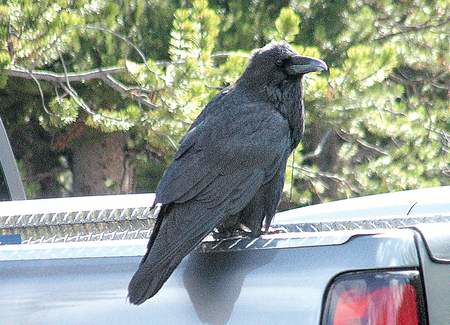Flocking south for the winter? Not these birds
Published 4:00 am Sunday, January 11, 2009

- Flocking south for the winter? Not these birds
A little bit of snow, wind or sleet can’t deter many of Central Oregon’s birds.
And in fact, winter can be a great time for birdwatchers.
Trending
“This is one of the fun times of year because there’s a lot of foliage on some types of trees,” said Nolan Harvey, wildlife biologist with the High Desert Museum. “It’s a lot of fun to see the smaller birds out and about. … There’s something pretty out there other than the snow.”
While some of Central Oregon’s birds migrate south for the winter to California or Mexico, some tough it out here. Others, ones that live at higher elevations or higher latitudes during the spring, summer and fall, migrate to Bend’s relative warmth in the winter. And some birders are noticing newcomers to Central Oregon in the cold months.
Several of the migrating birds that end up in Bend over the winter don’t come from far-off places, but instead spend the warmer months at higher elevations in the Cascade Range.
Townsend’s solitaire, a gray songbird in the thrush family, lives at a higher elevation during the summertime and then comes to spots like Bend during the winter, when it feeds on juniper berries. It’s one of the few birds that sings during the winter, said Tom Crabtree, a board member for the East Cascade Bird Conservancy, and it’s fairly common to spot in the colder months.
And the dark-eyed juncos follow the same pattern, summering in the mountain areas and flying east for the winter, said. Because they’re so much more prevalent this time of year, he said, some people call them snowbirds.
Other birds, like cedar wax wings and robins, tend to just shift south, said Chris Carey, wildlife biologist with the Oregon Department of Fish and Wildlife in Bend.
Trending
Some of those birds live here during the summer and migrate south, he said, but other individuals spend the summer north of Central Oregon and come here for the winter months.
“Everything kind of shifts down,” he said, adding that while it looks like robins live in Central Oregon year-round, it’s actually different birds in the different seasons.
People are also spotting birds during the winter that didn’t previously live in the region.
“The big mystery is, we do get some Anna’s hummingbirds around here,” Carey said. People have spotted the hummingbirds at feeders, he said, and it could be due to anything from a warming climate to more people leaving feeders up, or more people knowing to report unusual findings.
Say’s Phoebe flycatchers are also making appearances year-round in Oregon, when they used to just summer here — probably because of weather changes, he said.
“It’s probably all part of a natural movement of these populations in response to weather patterns,” Carey said. “We’re just now starting to maybe observe all of this.”
Birders are also spotting more and more western scrub jays, Crabtree said.
“This is a bird that is becoming more common at our feeders and is filling a (habitat) niche that wasn’t there before,” he said. Only in the last couple decades have birders noticed that kind of jay during the winter, but now it’s a common sight. He said he doesn’t know why, but it’s probably due to warmer winters.
But the weather can still be harsh in Central Oregon, and birds have tricks for staying warm and finding food during the winter.
People might bundle up and go out into the elements in even the coldest weather, but birds will expend as little energy as possible those days, Harvey said. When it’s windy out, they’ll stand behind a tree or a rock, turn their backs to the wind and hunker down.
“Essentially, even for small birds, they’re wearing fluffy down coats,” Harvey said. “(They can) puff out feathers, and wait it out.”
Some birds, like the California quail common to Central Or- egon, stick together to keep warm as well.
“They’ll climb into a juniper bush as a group and their body heat will keep them all warm. They’ll do like penguins do and hunker together,” Harvey said.
But every year, birds, especially if they’re weaker to begin with or the temperatures become too cold, get hypothermia and die, he said. And if water gets through their feathers, it can be bad.
“If they can’t keep themselves fluffed up and dry, they’re going to get soaked to their skin, and they just don’t have the body fat that we do,” Harvey said.
Often, it’s not the cold, but the availability of food that determines where the birds can winter, said Carey, with the Department of Fish and Wildlife.
Insect-eaters like warblers are going to have a hard time finding bugs in the winter, so they head south, he said. Other omnivores, like woodpeckers and nuthatches, can pick out insects from the bark of trees.
Some birds, like dark-eyed juncos, scratch through shallow layers of snow or poke around the sheltered areas around trees and shrubs to find seeds to eat, said Kevin Lair, owner of Wild Birds Unlimited in Bend.
“Birds, when it’s cold out, they have kind of a double-whammy,” Lair said. “They need more calories because it’s so cold, and on top of that (they’re) harder to find.”
Bend bird sightings
Each year, volunteers for the Audubon Society count and record all of the birds they see in a specific area on one day around Christmas. Below is a list of t
he most common birds (excluding ducks and geese) spotted in Bend on the Chr
1. Robin
• 2,085
• The most-spotted bird.
2. House finch
• 1,089
• A common visitor to bird feeders in winter.
3. House sparrow
• 1,086
• A non-native species.
4. Starling
• 855
• Another non-native, this “garbage bird” feeds on trash and displaces native birds.
5. Dark-eyed junco
• 738
• They winter here. Some come from British Columbia, others from the Cascade highlands to the lower elevations.
6. Cedar waxwing
• 652
• These birds breed elsewhere in the state and spend winter in the Bend area. Their numbers fluctuate depending on the berries available.
7. Mourning dove
• 565
• More have been seen here starting in 2001, increasing from 30 in the late 1980s.
8. Raven
• 380
• A common year-round bird, but in the fall and winter they travel in larger flocks.
9. California quail
• 346
• Numbers fluctuate with breeding success.
* Western scrub jay
• 143
• Though not in the top 10, the scrub jay is gaining ground here in winter; it’s more common in California.
Submitted photos
The Bulletin
Each year, volunteers for the Audubon Society count and record all of the birds they see in a specific area on one day around Christmas. (The robin, above, was No. 1 in Bend.) Nationwide, more than 18 million birds were counted. These are the three most common birds (excluding ducks and geese) spotted in Bend on the Christmas Bird Count, as reported by Tom Crabtree, a board member for the East Cascade Bird Conservancy. (The number is how many were spotted):
1. Robin (at top)
• 2,085
• The most-spotted bird. Some years, 15,000 have been seen.
2. House finch
• 1,089
• A common visitor to bird feeders in winter.
3. House sparrow
• 1,086
• A non-native species that birders aren’t fond of.
Submitted photos
For people who want to keep an eye on birds or want to help them out during the tough winter months, putting out calorie-rich feed is the way to go, said Kevin Lair, owner of Wild Birds Unlimited in Bend.
Black oil sunflower seeds are a favorite of songbirds like goldfinches and chickadees, and are dense in fat and calories, he said. Nuts, like shelled peanuts or tree nuts, also are good options.
Those kinds of birds will kick white millet out of feeders, but quails and doves and juncos will eat it off of the ground.
And for birds like woodpeckers, flickers, chickadees and nuthatches, suet — a cake of rendered beef kidney fat — provides energy for the winter.
“Birds don’t have to worry about heart disease, so they can eat that stuff,” Lair said. “It’s a good surrogate for insects.”
But beyond food, providing shallow water for the birds to drink and bathe in is a big boost, he said. Birds need to keep their feathers clean and oil free so they’re “poofier,” trapping more air and insulating them.
“All birds, regardless of what they eat, will take advantage of water,” Lair said.
— Kate Ramsayer, The Bulletin







